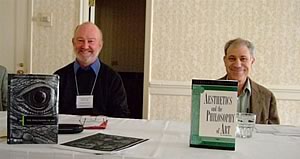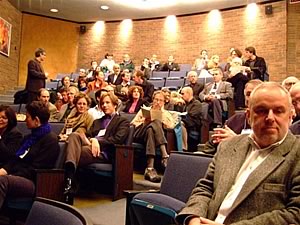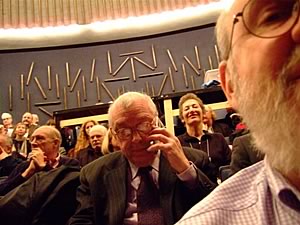Archive for October 2006
Area Man Lives in Fear that Attractive Woman Will Ask What’s on His iPod

DB here:
I’ve enjoyed Steven Levy’s technology books since Insanely Great, his (highly favorable) history of Apple. His newest one, The Perfect Thing: How the iPod Shuffles Commerce, Culture, and Coolness is a smooth ride, letting us in on the creation of the gadget, the rising power of iTunes, and the mesmerizing mystery of iPodolatry. I learn from Levy that people dress up their iPods, mourn their passing when the batteries die, and use them to meet strangers.
I was dimly aware of this last winter. I was sitting in my office and saw a young guy in the hall outside waiting for a class to start. He was watching a video on his pod and two young women came up to him. “Oooh, is that a fifth-generation iPod?” He showed it to them, and soon going out for coffee with them took precedence over going to class.
iPods invaded our house in two waves. Kristin goes to an Egyptian dig site in Amarna every year, mostly to work on registering statuary fragments, and as soon as she learned of Steve Jobs’ latest brain child, she wanted one. Now she could listen to her favorite music while standing for hours at a work table. I gave her a first-gen iPod for Christmas, and our computer assistant Brad Schauer helped her load it up with Handel, Mozart, and Vivaldi, mostly operas. She’s taken it over with her on every trip since.
I had no interest in listening to music as I moved through the world. I had tried a DiscMan long ago, but I didn’t like feeling insulated from the sounds around me. During travel, especially plane trips, I read. But when the video iPod came along, I thought that it had possibilities, so last winter I got one, the big mama with lots of GB.
By having Brad load Kristin’s baby, I now realize, I missed part of the fun: picking out what you’ll put on and arranging items into playlists. I also met with frustration. I hadn’t realized the dominance of pop music as a paradigm for all music until I bumped into iTunes. Of course it had no trouble with my boomer tracks (Burt Bacharach, the Drifters, Sam Cooke, etc.). But the program didn’t like art music. It chopped up operas so that little gaps appeared between tracks that should flow seamlessly, and it couldn’t read my old and obscure CDs. At one point, iTunes decided that all my Sibelius symphonies should be arranged by movement, so it grouped together seven first movements, seven second movements, and so on.
Reinstalling and upgrading the program, as well as setting up playlists, eventually solved these problems. Now my Mahler plays seamlessly and my Björk has the right pauses between songs. I still listen more seldom than most podders; not when walking around the world, mostly just in airports or in hotel rooms. More enticing has been the video function.
I’m a purist about moving images. I like movies on big screens, and grudgingly accept watching them on a tv monitor for convenience. I don’t much care for the look of images in home theatres; a lot of people, having invested so much in these behemoths, seem unable to see how mushy and artifact-ridden their systems are. (When I complained to a friend, he responded: “I like video artifacts the way you like grain.”) I often use a TV or computer monitor to study a film, but I very seldom watch a movie for the first time on a computer or other tiny display.
But my video iPod…well, I don’t love it or worship it, but I do admire and respect it and like to hang around with it.
Part of the attraction is, as Levy talks about at length, is the cool mystique of it. It is a good object. Its subtle heft and operating ease make it a pleasure to fondle. Then too, the very idea of it is entrancing. How can something so small store so many things that matter so much to us? But there’s another factor at work in the video iteration. I think that iPods also make the film viewing experience intimate in a way that other media don’t.
Levy talks about how Sony erred when it built two earphone jacks into the first Walkman. Morita believed that people would want to share the music with a friend. Wrong. Levy points out that it was all about privacy, about enclosing you in a bubble cut off from social interaction. Likewise, nobody can really watch your video iPod with you. It’s a little world addressed to you alone.

iPod version 0.0
In some ways we’re going through a period in which our audio-visual media are looking back to earlier forms. With multiplexes and Imax, big screens and 3-D presentations have returned in force; you’d think it was 1953 again. Similarly, the iPod rediscovers the Kinetoscope, Edison’s early peephole film system. Most were silent, but some were equipped with sync sound. You plugged in earphones, peered through a slot, and cranked a long film loop through. It was an arcade attraction without much of a future; large-scale success came to the system that projected images for a crowd. Now, however, we can have a portable Kinetoscope, and the fact that it’s at our command (stop, go back, skip over, shuffle) probably makes it all the more mesmerizing.
For the most part, I don’t watch fiction films on my iPod. I watch documentaries, most repetitively Adam Curtis’s The Power of Nightmares, one of the great docs of recent years. I don’t watch TV at home, but I catch up with shows like The Shield and The Wire via my iPod. I watch some YouTube clips, especially the Two Chinese Students (aka Back Dorm Boys), which always give me a lift.
But I confess I’ve also put on films that work, for me, like favorite music. These are films I know well and love to look at in idle moments. I play the reconstruction of Eisenstein’s Bezhin Lug, with stirring Prokofiev audio extracts; Les demoiselles de Rochefort; Feuillade’s Fantomas; Akerman’s Golden 80s; Lang’s Spies; episodes of Twin Peaks. Except for the Demy, all fit nicely in the 3×4 window. All lift my spirits.
Cooler people download Lost or store their pictures or swap playlists with others, but my needs are more prosaic. This digital version of peephole cinema supplies me with comfort food.
The End of cinema as we know it—yet again
Kristin here—
Our friend Brian Rose kindly send us a recent article from the Wall Street Journal, Joe Morgenstern’s “Set the DVD Player to ‘Random’” (28 October 2006, p. 10; the WSJ website is by subscription and wouldn’t let me link to the article). In it Morgenstern claims that iPods playing songs in random order, video games offering constant choice, multi-tasking, and all the supposedly distractive aspects of modern life are wrecking movie logic. The latest evidence? A new release called The Onyx Project, an inexpensively produced interactive movie starring David Strathairn that allows its viewer to wander through the narrative in random order.
According to Morgenstern, The Onyx Project is just further indication that “The entire entertainment industry is beset by fragmentation, both economic and perceptual. Kids who used to turn out for movies every weekend now devote themselves to videogaming, instant messaging, MySpacing and YouTubeing, sometimes simultaneously, while movie executives, pacing studio corridors, worry rightly that they no longer understand how kids’ minds work.” (Haven’t studio execs always paced and worried about how to understand spectators’ minds?)
Morgenstern even cites Pauline Kael’s essay, “Are Movies Going to Pieces?” where she cited the “creeping Marienbadism” in modern cinema. If only! Yes, I can just see today’s teenagers lamenting the fact that Last Year at Marienbad is out of print on DVD and searching eBay for it. Morgenstern simultaneously cites Marienbad as having brought fragmentation into the movies and praises such art films as Breathless, L’Avventura, and Caché, as well as sophisticated Hollywood storytelling in The Matrix and The Godfather Part II. But again, if fragmentation is what kids want, why aren’t they watching Caché?
It’s hard to know where to begin.
For a start, the makers of The Onyx Project declare on its website, “But NAVworlds are not movies.” (NAV stands for “Non-Linear Arrayed Video.”) Further, “They are not ‘interactive movies.’” The site compares these NAVworlds, quite logically, to videogames, but there’s a difference: “Video games present worlds. We love video games. But video games are programmed. NAVworlds are written, directed, acted and edited.” It’s a subtle distinction, but the point is, The Onyx Project is probably closer to a game than a movie. The fact that it is available only as a piece of software playable in computers but not in DVD players should be a clue.
But whatever we call The Onyx Project, is it really totally fragmented? Richard Siklos’ more temperate New York Times review, “In This Movie, the Audience Picks the Scene” (2 October 2006) points out that The Onyx Project retains some of the traits of a Hollywood narrative. “One idea behind the venture,” he declares, “is that no two viewers may see the movie unfold in the same way, yet its basic facts, characters and message will permeate the experience.
Sounds like a type of unity to me. Moreover, “The mystery at the center of the story is not revealed until the end.” Suspense and curiosity are maintained, controlled not by the viewer/player but the makers.
Let’s go back to that “The entire entertainment industry is beset by fragmentation” claim. One of the reasons that The Onyx Project is creating a little stir is that it is so atypical. These kinds of experiments in time shifting are often used specifically for mysteries, traditionally the genre where the story starts the latest in the action and then backtracks for the final reveal. Think Memento, The Usual Suspects, or any of the neo-noir follow-ups to Pulp Fiction.
In 1985 when Hollywood attempted to introduce a mild form of forking-paths storytelling into theatrical filmmaking, they chose Clue, not only a mystery but a game. Then viewers simply saw one of three possible endings. Presumably the spectator was supposed to be intrigued by this gimmick and see the film three times. Few proved willing to sit through it even once, and the film flopped. Naturally all three endings were included in the video release, giving the viewer a mild dose of interactivity. Now the technology has caught up to make this approach far more sophisticated and intriguing.
More important, though, is the fact that most movies that young people see in theaters are not fragments or shuffled in challenging ways. Pirates of the Caribbean: Dead Man’s Chest may have been too long, but its cause-effect flow wasn’t fragmented, and it has earned over a billion dollars worldwide. Look at the most popular and/or lauded films of the past decade: Titanic, The Lord of the Rings, The Chronicles of Narnia, A Beautiful Mind, Spider-Man, Finding Nemo … the list could go on and on. These films are linear and causally tight for the most part, and when something is unclear, it’s a mistake, not a deliberate strategy. Even The Sixth Sense (another mystery of sorts) is easy to follow, and the twist, though genuinely surprising for most, is not baffling. A truly fragmented narrative is hard to find, in part because these sorts of films appeal to a very broad audience and have to be comprehensible if they are to succeed.
It’s easy to link the coincidence of the invention of gadgets like iPods with the trend toward Memento-like trickiness. As usually happens if one looks closely, though, complex narratives of this sort predate modern forms of interactivity. Even apart from the art cinema (whose main audiences from the end of World War II well into the 1970s and 1980s contained a large number of college students and graduates), there are Hollywood films that play with time in pretty sophisticated ways. In the 1940s there were the films noir, like Double Indemnity and The Locket, the latter with its flashbacks nested like matrioshki dolls. Later on but still in the pre-iPod era, there were playful films like Groundhog Day (1993) and Pleasantville (1998). MTV and the 1970s generation of American auteurs brought up on art cinema probably had more impact on story-telling than the iPod and similar devices have.
Moreover, even in traditional arts where interactivity would seem highly unlikely, one can find occasional works that offer choices. The Choose Your Own Adventure series of children’s books (1979 to the present) include numerous options about how to proceed. (Greg Lord offers an analysis of one of the books.)
Besides all that, the shuffle feature on iPods is usually used for songs, which are short, self-contained artworks. I doubt that people watching old episodes of Moonlighting on their video iPods skip among chapters randomly.
One thing most people tend to forget (if they ever knew it) is that in pre-television days, when movie theaters were a lot fuller than they tend to be now, there were continuous screenings. That meant the times when the screenings would start were not typically given in ads, and people just went to the theater, often standing in line until a seat became available. A lot of people ended up coming in in the middle of the feature and just sat through until they got to that point again. They didn’t seem to be much bothered by the fact that the film was “fragmented” in a random way. (In Storytelling in the New Hollywood I argue that comprehension was aided by a considerable redundancy in the flow of narrative information. David picks up on that idea in The Way Hollywood Tells It.) Notably, among the first theaters to list start times and sell reserved seats were early art houses, presumably because the more challenging films shown there were less easy to grasp unless seen beginning to end.
If The Onyx Project succeeds, it may usher in a new storytelling medium somewhere between films and videogames. If not, it will be the Clue of its day. Either way, most filmmakers in Hollywood and elsewhere will continue to try and make movies with stories that people can easily follow.
ArtTalk brewing in Milwaukee
David here:
At a yard sale you find a really nifty yellow ray gun. You had one just like it when you were six. You loved that ray gun. Your hand tingles as you heft this one. It evokes memories of you and your pals playing in the schoolyard.
It’s only $2.50. You buy it.
When you get home, you examine it closely and find that it’s a brand-new replica, made by a company that specializes in retro toys. Suddenly you don’t like it so much.
But why? It’s identical to the ray gun you owned. It’s made from the same plastic and in the same colors. It’s definitely in better condition than an original would be. So why do you feel dissatisfied?
This is the sort of question philosophers of art ponder, though they usually put it more abstractly. Art, we might say, is about appearances–the way something looks (or sounds). People enjoy Leonardo’s Mona Lisa because of the way it looks. If an artist today could make a perfect copy of the Mona Lisa, right down to the individual brush strokes, then that copy should be as enjoyable as the original. Yet a lot of people have the gut feeling that today’s copy somehow can’t offer the same experience as the original.
So aestheticians ask whether there is more to the enjoyment of art than just the appearance of the work. Maybe part of our experience of art involves our sense of the history of art works, an appreciation of where they came from and what they’ve been through. Such a sense isn’t just background information but an integral part of the properly aesthetic experience we have.

The authors and their books.This was one of the themes that surfaced regularly in my stay at the annual convention of the American Society for Aesthetics. (My first blog on this event is here.) There was a tribute to Arthur Danto, who formulated this problem twenty-five years ago in his trailblazing book The Transfiguration of the Commonplace. (He coined the term “indiscernibles” in his discussion of Andy Warhol’s Brillo boxes.) The day after the Danto session, a panel discussion of two new introductory textbooks, Stephen Davies’ Philosophy of Art and Robert Stecker’s Aesthetics and the Philosophy of Art, raised issues that intersected with this concern.
Both Davies and Stecker discuss how recent conversations in the field move toward the idea that our experience of a picture or poem or play brings into play assumptions about the work’s historical existence. As I understand it, this is one of the differences between traditional aesthetics, concerned with apprehension of beauty as something immediately apparent, and philosophy of art, which asks about all the factors that go into our understanding and enjoying art.
By the way, this panel was punctuated by hilarious comments throughout. Philosophers definitely have a sense of humor. One of the panelists, Ted Cohen, has even written a philosophical study of jokes.

Part of the crowd for Carolyn Korsmeyer’s ASA presidential address.

Curtis Carter, Director of the Haggerty Museum, with Professor Stephanie Ross behind. The theme of indiscernibles was central to the fascinating talk by ASA President Carolyn Korsmeyer of SUNY–Buffalo. She argued that genuineness isn’t just a property we add on to artworks that beguile us. Central to the experience of many artworks is the sense of what she called age value, a “palpable contact with the past.” Her examples ranged from historic “reconstructions” of public spaces (e.g., the Erie Canal terminus in Buffalo) to recipes that include non-synthetic ingredients.
How far can we get from the original? Professor Korsmeyer plotted out a continuum, starting with a worn original through stages of repair (using glue from the same period, say, to patch up a cathedral window), restoration, rebuilding, and replication (making a copy in a comparable substance) to end in multiple reproduction (a photo of the Mona Lisa). As we go along the continuum, the age value decreases and what we can appreciate narrows ever more to surface qualities. We move, she suggests, toward “aesthetic deception,” where we risk losing the original altogether. That’s what happened at the yard sale with your ray gun.
The talk set me thinking about how cinephiles appreciate the various versions of films we encounter. Would you rather watch a 1941 35mm print of How Green Was My Valley, a recent 35mm print from the negative, a version taken from the restored negative, or a DVD reproduction? An original, which Kristin and I have seen, can be unbelievably beautiful. Shot on nitrate stock, it has a luster and a fine grain that isn’t captured on safety stock, which came into use after World War II. (Projectionists accustomed to the sharpness of nitrate claimed that safety film was soft and hard to focus.) So there were definite aspects of sheer appearance that contributed to our enjoyment of the film.
But the print of How Green that we saw was a bit worn, with scratches and missing frames. Can we argue that these added age value? Did our knowledge that this was a print that might have been watched by a 1941 audience deepen our sense of the film’s worth? Likewise, even if a sparkling, cleaned-up DVD could adequately capture the look of the nitrate original (it can’t), does its distance from the original take away some of the film’s appeal?
I’m tempted to answer yes, but it’s hard to generalize. Who’d prefer an original, faded-to-pink print of a 1950s Eastmancolor movie to a DVD copy with the colors more or less restored? The pink puts us all too palpably in contact with the past, but what it adds in age value overrides what it takes away in surface qualities.
And sometimes cases are just mixed, I think. For some years I had access to an original Technicolor release print of The Godfather. I loved watching it because the color was never approximated in any other versions I’d seen: the dreadful rereleases, the laserdiscs, even the different DVD versions. Kay’s Republican topcoat lost its ripe light burgundy color in all the video versions.
But at the same time, I was perpetually shocked by how grainy the original Tech print looked. Gordon Willis’s famous enveloping blackness was teeming with grain. (He really pushed the film stock, it’s evident.) The newer prints and the anamorphic DVD versions yield a smoother texture. The film’s harsh graininess is part of age value, but even if the restoration seems guided by contemporary tastes (in this case, our fondness for crisp digital imagery), you could argue that purging the grain enhances the film’s visibility, and hence its sensuous appeal.
The issue is about to crop up again. I learned from the film cadre at ASA that we’re about to get yet another version of Blade Runner, some final director’s cut, in both theatrical and DVD release. Again, I had access to a 35mm print of the original theatrical version, complete with voice-over and enigmatic origami unicorn. That print was monophonic and fading. But the original theatrical version was evidently never released on video or re-released theatrically,so the print has purely documentary value.
There’s more, however. Call it fetishism or nostalgia, but watching that crummy print made me feel I was in contact with Blade Runner as a historical entity, the thing that people (too few) saw back in June 1982. So I think there’s something intuitively right about the philosophers’ idea. Maybe André Bazin anticipated this argument when he argued that when we look at photographs, our knowledge of their origins is an inescapable part of their beauty.
Professor Korsmeyer’s talk took place on the Marquette University campus, and was followed by a reception at the lovely Haggerty Museum there. The museum was hosting a screening (on video) of Hockey Seen, a multimedia dance piece by philosopher Nelson Goodman, and several artists, including the composer then known as John C. Adams. The fact that a philosopher collaborated with several artists on the work seems a good emblem for the goal of the American Society for Aesthetics. These philosophers stay in close touch with the subjects they ponder–art, artists, and audiences.
Seen in a Milwaukee T-shirt shop:
Guns don’t shoot people.
Dick Cheney shoots people.
Milwaukee: Philosophers turn arty
Today the Virginia senatorial campaign seems to revolve around whether you reveal yourself to be a bad person if you write a novel with disturbing or naughty scenes. It’s the sort of question routinely considered, more dispassionately, by the members of the American Society for Aesthetics. The Society consists mostly of professors, mostly of philosophy, who try to understand the most basic principles of how art works. I’ve been at their annual conference in Milwaukee since Wednesday night.





The Milwaukee Hilton Hotel
The event is held in the Hilton, an opulent building finished in 1928 (that is, just before opulence went away for quite a while). It’s an overpowering, somewhat eerie place, a little like the hotel in The Shining. Chandeliers hang from high ceilings. Corridors stretch on forever, silent and empty. Around any corner you may find a painting, a throne, or a signpost pointing you in several directions. You don’t exactly get lost, but the sheer size of the place, along with the occasional touch of Midwestern kitsch, suggests Last Year at Marienbad redecorated to suit the Amberson family. The same aesthetic principles, blown out to a more humungous scale, gave us The House On The Rock, one of Wisconsin’s great contributions to grassroots Dada.
In my first day here, there were intriguing papers and discussions. I couldn’t go to all of them, but I did visit a session on artistic genius. Peter Kivy’s paper, “Mozart’s Skull,” argued that an artist we acclaim as a genius raises some problems for ordinary mortals. Genius disturbs us, especially genius in very young people, like the prodigy Mozart. Genius is also very mysterious; we don’t know how someone like Mozart could produce so much music of such high quality—indeed of perhaps the highest quality in the Western art-music tradition.
Kivy believes, as I understood it, that genius is a real quality that we can’t explain by trends in taste or strategies of careerism. He castigated what he called “political deconstructionists” who want to deny that genius exists. In his account, they try to show that praise for gifted artists is actually PR: the reputation is constructed by historical circumstances and has nothing actual at the center. Kivy insisted that, regardless of how his career was promoted, Mozart was truly gifted by orders of magnitude beyond nearly all composers. So how to explain those gifts?
Kivy suggests that genius is a mystery that we may never be able to solve. He compares his argument to one floated by philosopher Colin McGinn, who suggests that consciousness is the sort of problem that we may never resolve, because it’s just not in the cards for creatures like us. That’s not to say that the explanation would be supernatural, as if, say, Mozart was truly kissed by God. (The play and movie, Amadeus, use his middle name to play with this possibility.) Maybe there are non-supernatural factors that create a genius; but we might not ever be able to detect them.
The questions raised in the discussion period were fascinating, with a couple of people saying that one could study how Mozart’s reputation was constructed through social institutions of the time without denying that the basis of the reputation was the genuine excellence of the music. Another listener pointed out that Mozart’s reputation is something of a special case. He was praised and understood instantly, but the music of the late Beethoven puzzled people who had acclaimed his earlier work; it took later generations to see the “genius” embodied in the Ninth Symphony and the late string quartets. Maybe the standard of genius does indeed change with time.
I began to muse over whether we cinephiles ever talk about great filmmakers as true geniuses. Even the directors that are most admired across film history—Renoir, Ozu, Welles, Hitchcock, Dreyer, Eisenstein, Hitchcock, etc.—don’t usually get called “geniuses.” Perhaps this way of talking about artists is part of a classical-art tradition that film never joined…or came too late to join.
A longer session was devoted to comments on my old friend Paisley Livingston’s book Art and Intention. I’ve mentioned this book elsewhere on this site, and it seems to me a remarkable attempt to show how an idea of intentional action can help explain creative processes in art. For students of film, his ideas about collective artistic creation—several people pooling efforts to make a film or some other work—are particularly interesting. In this panel, several other distinguished philosopher of art analyzed, praised, and criticized the views expressed in the book.
That night, after my own talk on early CinemaScope, we went to a reception at the lovely Milwaukee Institute of Art and Design. (Animator Bill Plympton will be visiting it soon.) Across the evening, I met several people keenly interested in cinema–actually, who isn’t? Our talk about movies went on for a long time, continuing in a pub in the hotel. There was a reunion of former Madison philosophy students, all protégées of Noel Carroll, and it was fun to talk movies with them. I don’t think I convinced them that Tom Cruise and Keanu Reeves are excellent screen actors, though they were more sympathetic to my case for Sandra Bullock.
Next day I skipped the ASA sessions to go book-hunting with Paisley. Among other stops, we visited the Renaissance Bookstore, another Wisconsin monument. Several stories high, the collection of old books and magazines is monumentally daunting. This is where all books go to die, in dust. Still, I found mysteries by my new passion, George V. Higgins. Earlier that day, I picked up Scott McCloud’s Making Comics, which looks like a worthy successor to his superb Understanding Comics and his followup, Reinventing Comics. Film scholars can learn a lot from comic art (graphic novels, comic strips, etc.), and McCloud is the best guide to the aesthetics of comics I know. Come to think of it, he should be invited to the next ASA convention. . . .













